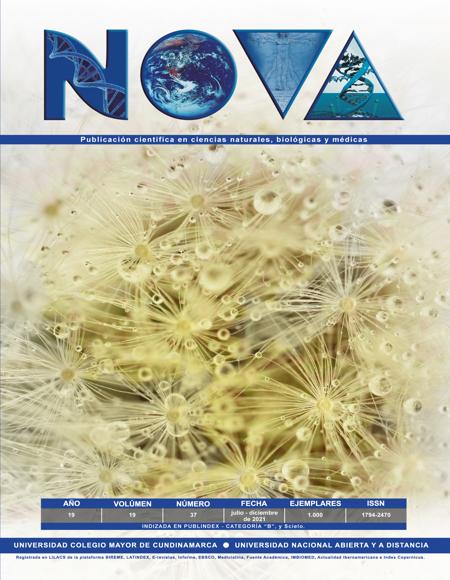IN VITRO ANTIMICROBIAL ACTIVITY OF DOURO WINES AGAINST CLINICAL HELICOBACTER PYLORI STRAINS
ACTIVIDAD ANTIMICROBIANA IN VITRO DE LOS VINOS DEL DUERO SOBRE CEPAS CLÍNICAS DE HELICOBACTER PYLORI
Show authors biography
In vitro antimicrobial activities of seven wines (5 reds and 2 whites) from the Douro region (Iberian Peninsule) against eleven clinical strains of Helicobacter pylori were evaluated. The disk diffusion method, using Columbia Agar supplemented with horse blood (CAB), were used to determine the antimicrobial properties of some wine components against H. pylori strains. Potential interactions of antioxidants contained in the wines and two antimicrobials (amoxicillin and metronidazole) were studied by the disk diffusion method. All the tested strains showed growth in CAB supplemented with 9% of the tested wines but none of them grew in media supplemented with 45% and 67.5% of wine. Similarly, all the tested strains grew in media with the concentration of proanthocyanidins present in the different types of the studied wines. The Minimal Inhibitory Concentration (MIC) values of the wine antioxidant components tested (benzoic acid, catechin, quercetin, and resveratrol) indicate that resveratrol was the most powerful inhibitory substance against H. pylori. An effect of potentiation between amoxicillin and metronidazole and the antioxidants tested was also established. The interaction of amoxicillin and resveratrol or metronidazole and catechin increased the antimicrobial activity against H. pylori. The results obtained suggested a potential role of resveratrol as a chemopreventive agent for H. pylori infection.
Article visits 193 | PDF visits 174
Downloads
- Kusters JG, van Vliet AHM, Kuipers E. Pathogenesis of Helicobacter pylori infection. Clin Microbiol Rev. 2006; 19:449-490. https://www.ncbi.nlm.nih.gov/pmc/articles/PMC1539101/pdf/0054-05.pdf
- Du MQ, Isaccson PG. Gastric MALT lymphoma: from aetiology to treatment. Lancet Oncol. 2002; 3:97-104. https://www.sciencedirect.com/science/article/pii/S1470204502006514?via%3Dihub
- Sachs G, Weeks DL, Melchers K, Scott DR. The gastric biology of Helicobacter pylori. Annu Rev Physiol. 2003; 65:349-369. https://www.annualreviews.org/doi/pdf/10.1146/annurev.physiol.65.092101.142156
- Dundon WG, de Bernard M, Montecucco C. Virulence factors of Helicobacter pylori. Int J Med Microbiol. 2001; 290:647-658. doi: 10.1016/s1438-4221(01)80002-3.
- Laheij RJ, Rossum LG, Jansen JB, Straatman H, Verbeek AL. Evaluation of treatment regimens to cure Helicobacter pylori infection: a meta-analysis. Aliment Pharmacol Ther. 1999; 13:857-864. https://onlinelibrary.wiley.com/doi/epdf/10.1046/j.1365-2036.1999.00542.x
- Malfertheiner P, Mégraud F, O'Morain C, Hungin APS, Jones R, Axon A, et al. Current concepts in the management of Helicobacter pylori infection-the Maastricht 2-2000 Consensus Report. Aliment Pharmacol Ther. 2002; 16:167-180. https://onlinelibrary.wiley.com/doi/epdf/10.1046/j.1365-2036.2002.01169.x
- Debets-Ossenkopp YJ, Namavar F, MacLaren DM. Effect of an acidic environment on the susceptibility of Helicobacter pylori to trospectomycin and other antimicrobial agents. Eur J Clin Microbiol Infect Dis. 1995; 14:353-355. doi: 10.1007/BF02116532.
- Gerrits MM, van Vliet AHM, Kuipers E, Kusters JG. Helicobacter pylori and antimicrobial resistance: molecular mechanisms and clinical implications. The Lancet Infect Dis. 2006; 6:699-709. https://www.sciencedirect.com/science/article/pii/S1473309906706272?via%3Dihub
- Macias-Garcia F, Llovo-Taboada J, Diaz-Lopez M, Baston-Rey I, Dominguez-Munoz JE. High primary antibiotic resistance of Helicobacter pylori strains isolated from dyspeptic patients: a prevalence cross-sectional study in Spain. Helicobacter. 2017;22: e12440. https://onlinelibrary.wiley.com/doi/epdf/10.1111/hel.12440
- Alba C, Blanco A, Alarcon T. Antibiotic resistance in Helicobacter pylori. Curr Opin Infect Dis. 2017;30: 489-497. https://journals.lww.com/co-infectiousdiseases/Fulltext/2017/10000/Antibiotic_resistance_in_Helicobacter_pylori.8.aspx
- Walduck AK, Raghavan S. Immunity and vaccine development against Helicobacter pylori. In: Kamiya S, Backert S, eds. Helicobacter pylori in Human Diseases. Advances in Experimental Medicine and Biology, vol 1149, Cham.: Springer; 2019. p. 257-275. https://link.springer.com/chapter/10.1007%2F5584_2019_370
- Collado MC, Gonzalez A, Gonzalez R, Hernandez M, Ferrus MA, Sanz Y. Antimicrobial peptides are among the antagonistic metabolites produced by bifidobacterium against Helicobacter pylori. Int J Antimicrob Agents. 2005; 25:385-391. https://www.sciencedirect.com/science/article/pii/S0924857905000312?via%3Dihub
- Stojilijkovic I, Evavold BD. (2001) Antimicrobial properties of porphyrins. Expert Opin Investig Drugs. 2001; 10:309-320. https://www.tandfonline.com/doi/abs/10.1517/13543784.10.2.309
- Ohno T, Kita M, Yamaoka Y, Imamura S, Yamamoto T, Mitsufuji S, et al. Antimicrobial activity of essential oils against Helicobacter pylori. Helicobacter. 2003; 8:207-215. https://onlinelibrary.wiley.com/doi/full/10.1046/j.1523-5378.2003.00146.x?sid=nlm%3Apubmed
- Tombola F, Campello S, De Luca L, Ruggiero P, Del Giudice G, Papini E, et al. Plant polyphenols inhibit VacA, a toxin secreted by the gastric pathogen Helicobacter pylori. FEBS Lett. 2003; 543:184-189. https://febs.onlinelibrary.wiley.com/doi/full/10.1016/S0014-5793%2803%2900443-5?sid=nlm%3Apubmed
- Eurogast Study Group. Epidemiology of, and risk factors for, Helicobacter pylori infection among 3194 asymptomatic subjects in 17 populations. Gut. 1993; 34:1672- 1676. https://www.ncbi.nlm.nih.gov/pmc/articles/PMC1374460/
- Brenner H, Rothenbacher D, Bode G, Adler G. Relation of smoking and alcohol and coffee consumption to active Helicobacter pylori infection: Cross sectional study. Br Med J. 1997; 315:1489-1492. https://www.ncbi.nlm.nih.gov/pmc/articles/PMC2127930/
- Bujanda L. The effects of alcohol consumption upon the gastrointestinal tract. Am J Gastroenterol. 2000; 95:3374-3382. https://insights.ovid.com/pubmed?pmid=11151864
- Brenner H, Bode G, Adler G, Hoffmeister A, Koenig W, Rothenbacher D. Alcohol as a gastric disinfectant? The complex relationship between alcohol consumption and current Helicobacter pylori infection. Epidemiology. 2001; 12:209-214. https://journals.lww.com/epidem/Fulltext/2001/03000/Alcohol_as_a_Gastric_Disinfectant__The_Complex.13.aspx
- Murray LJ, Lane AJ, Harvey IM, Donovan JL, Nair P, Harvey RF. Inverse relationship between alcohol consumption and active Helicobacter pylori infection: The Bristol Helicobacter Project. Am J Gastroenterol. 2002; 97:2750-2755. https://insights.ovid.com/pubmed?pmid=12425543
- Marimon JM, Bujanda L, Gutierrez-Stampa MA, Cosme A, Arenas JI. In vitro bactericidal effect of wine against Helicobacter pylori. Am J Gastroenterol. 1998; 93:1392. https://insights.ovid.com/pubmed?pmid=9707086
- Glupczynski Y. Culture of Helicobacter pylori from biopsies and antimicrobial susceptibility testing. In: Megraud F, Lee A, eds. Helicobacter pylori: Techniques for Clinical Diagnosis and Basic Research, Oxford: WB Saunders Company, p. 17-32. 1996.
- Megraud F, Lee A. Helicobacter pylori: Techniques for Clinical Diagnostics and Basic Research. Oxford: WB Saunders Company; 1996.
- CLSI/NCCLS. Performance Standards for Antimicrobial Susceptibility Testing. Approved Standard M100-S19. Wayne: CLSI; 2009.
- National Committee for Clinical Laboratory Standards (NCCLS). Development of in vitro Susceptibility Testing Criteria and Quality Control Parameters, 5th Ed. Philadelphia: American Society for Testing of Materials; 2018.
- Oleastro M, Gerhard M, Lopes AI, Ramalho P, Cabral J, Guerreiro AS, et al. Helicobacter pylori virulence genotypes in Portuguese children and adults with gastroduodenal pathology. Eur J Clin Microbiol Infect Dis. 2003; 22:85-91. https://link.springer.com/article/10.1007/s10096-002-0865-3
- Tummuru MKR, Cover TL, Blaser MJ. Cloning and expression of a high-molecular- mass major antigen of Helicobacter pylori: Evidence of linkage to cytotoxin production. Infect Immun. 1993; 61:1799-1809. https://www.ncbi.nlm.nih.gov/pmc/articles/PMC280768/
- Atherton JC, Cao P, Peek RM. Mosaicism in the vacuolating cytotoxin alleles of Helicobacter pylori. Association of specific vacA types with cytotoxin production and peptic ulceration. J Biol Chem. 1995; 270:17771-17779. https://www.sciencedirect.com/science/article/pii/S0021925817480100?via%3Dihub
- Roggero JP, Coen S, Archier P, Rocheville-Divorne C. Etude par C.L.H.P. de la reaction glucoside de malvidine-acetaldehyde-compose phenolique. Conn Vigne Vin. 1987; 21:163-168. https://oeno-one.eu/article/view/1283
- Megraud F, Lehours P. Helicobacter pylori detection and antimicrobial susceptibility testing. Clin Microbiol Rev. 2007; 20:280-322. https://www.ncbi.nlm.nih.gov/pmc/articles/PMC1865594/
- Ecclissato C, Marchioretto MAM, Mendonça S, Godoy APO, Guersoni RA, Deguer M, et al. Increased primary resistance to recommended antibiotics negatively affects Helicobacter pylori eradication. Helicobacter. 2002; 7:53-59. https://onlinelibrary.wiley.com/doi/full/10.1046/j.1523-5378.2002.00056.x?sid=nlm%3Apubmed
- Lee SY, Shin YW, Hahm KB. Phytoceuticals: mighty but ignored weapons against Helicobacter pylori infection. J Dig Dis. 2008; 9:129-139. https://onlinelibrary.wiley.com/doi/full/10.1111/j.1751-2980.2008.00334.x
- Daroch F, Hoeneisen M, Gonzalez CL, Kawaguchi F, Salgado F, Solar H, et al. In vitro antibacterial activity of Chilean red wines against Helicobacter pylori. Microbios. 2001; 104:79-85. https://pubmed.ncbi.nlm.nih.gov/11297014/
- Just JR, Daeschel MA. Antimicrobial effects of wine on Escherichia coli O157:H7 and Salmonella typhimurium in a model stomach system. J Food Sci. 2003; 68:285- 290. https://onlinelibrary.wiley.com/doi/epdf/10.1111/j.1365-2621.2003.tb14154.x
- Møretrø T, Daeschel MA. Wine is bactericidal to foodborne pathogens. J Food Sci. 2004; 69:M251-257. https://onlinelibrary.wiley.com/doi/epdf/10.1111/j.1365-2621.2004.tb09938.x
- Friedman M. Antibacterial, antiviral, and antifungal properties of wines and winery byproducts in relation to their flavonoid content. J Agric Food Chem. 2014; 62:6025- 6042. https://pubs.acs.org/doi/10.1021/jf501266s
- Kamei H, Hashimoto Y, Koide T, Kojima T, Hasegawa S. Anti-tumor of methanol extracts from red and white wines. Cancer Biother Radiopharm. 1998; 13:447-452. https://www.liebertpub.com/doi/10.1089/cbr.1998.13.447?url_ver=Z39.88-2003&rfr_id=ori%3Arid%3Acrossref.org&rfr_dat=cr_pub++0pubmed&
- Belleville J. The French paradox: possible involvement of ethanol in the protective effect against cardiovascular diseases. Nutrition. 2002; 18:173-177.
- Daglia, M. Polyphenols as antimicrobial agents. Curr Opin Biotechnol. 2012; 23:174- 181. https://www.sciencedirect.com/science/article/pii/S0899900701007213?via%3Dihub
- Mahady GB, Pendland SL. Resveratrol inhibits the growth of Helicobacter pylori in vitro. Am J Gastroenterol. 2000; 95:1849. https://insights.ovid.com/pubmed?pmid=10926010
- Wang D, Xu Y, Liu W. Tissue distribution and excretion of resveratrol in rat alter oral administration of Polygonum cuspidatum extract (PCE). Phytomedicine. 2008; 15:859-866. https://www.sciencedirect.com/science/article/pii/S0944711308000287?via%3Dihub
- Orallo F. Trans-resveratrol: a magical elixir of eternal youth?. Curr Med Chem. 2008; 15:1887-1898. https://pubmed.ncbi.nlm.nih.gov/18691046/
- Mahady GB, Pendland SL, Chadwick LR. Resveratrol and red wine extracts inhibit the growth of CagA + strains of Helicobacter pylori in vitro. Am J Gastroenterol. 2003; 98:1440-1441. https://www.ncbi.nlm.nih.gov/pmc/articles/PMC2860858/
- Dong W, Zhon Y, Yang Z. Research progress of mechanism of action of resveratrol. Pharmacol Pharm. 2016; 7:170-175. DOI: 10.4236/pp.2016.74022
- Ghiara P, Marchetti M, Blaser MJ, Tummuru MK, Cover TL, Segal ED, et al. Role of the Helicobacter pylori virulence factors vacuolating cytotoxin, CagA, and urease in a mouse model of disease. Infect Immun. 1995; 63:4154-4160. https://www.ncbi.nlm.nih.gov/pmc/articles/PMC173584/
- Salama NR, Otto G, Tompkins L, Falkow S. Vacuolating cytotoxin of Helicobacter pylori plays a role during colonization in a mouse model of infection. Infect Immun. 2001; 69:730-736. https://www.ncbi.nlm.nih.gov/pmc/articles/PMC97945/
- Hemaiswarya S, Kruthiventi AK, Doble M. Synergism between natural products and antibiotics against infectious disease. Phytomedicine. 2008; 15:639-652. https://www.sciencedirect.com/science/article/pii/S0944711308001104?via%3Dihub
- Sung WG, Lee DG. Mechanism of decreased susceptibility for Gram-negative bacteria and synergistic effect with ampicillin of indole-3-carbinol. Biol Pharm Bull. 2008; 31:1798-1801. https://pubmed.ncbi.nlm.nih.gov/18758080/









